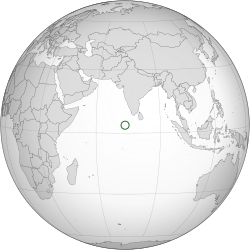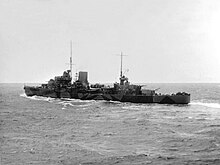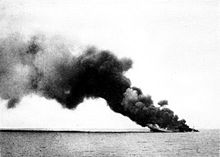Action of 27 February 1941
| Action of 27 February 1941 | |||||||
|---|---|---|---|---|---|---|---|
| Part of the Indian Ocean theatre of the Second World War | |||||||
 Maldive Islands (orthographic projection) | |||||||
| |||||||
| Belligerents | |||||||
|
|
| ||||||
| Commanders and leaders | |||||||
| Robert Bevan | Alfredo Bonezzi | ||||||
| Strength | |||||||
| Light cruiser Leander | Auxiliary cruiser Ramb I | ||||||
| Casualties and losses | |||||||
| Leander slightly damaged |
Ramb I sunk c. 150 killed 100 captured of whom: 4 wounded (1 died of wounds) | ||||||
The Action of 27 February 1941 was a
Background
East African Campaign
In January 1941, British forces simultaneously advanced from
HMS Leander
Ramb I

Ramb 1 (3,667
Prelude

Acting on reports of commerce raiders in the area, Leander detached from Convoy US 9 off Bombay on 22 February.[7] Passing west of the Laccadive and Maldive islands, to a patrol area west of Huvadhu Kandu (One and a Half Degree Channel). At 7:00 a.m. on 27 February, Leander was steaming east, about 28 nmi (52 km; 32 mi) north of the Equator and 320 nmi (590 km; 370 mi) west of the Maldives (01° N, 68° 30′ E).[8] Captain Robert Bevan, altered course to the north to head for One and a Half Degree Channel, because news of the capture of Mogadishu in Italian Somaliland (now Somalia) had been received by radio on the previous day. Italian ships in the port might have sailed along that route for the Far East.[2]
Action
At 10:37 a.m., a ship was sighted ahead and Leander increased speed to 23 kn (43 km/h; 26 mph), gradually overhauling the vessel. As Leander closed, a gun was seen on the ship's forecastle and the silhouette of the ship resembled an Italian Ramb-class fruit carrier. Leander went to action stations at 11:15 a.m. and when ordered to identify itself ten minutes later, the crew of the vessel hoisted a British merchant flag. When ordered to give its signal letters, the crew hoisted four letters which were not listed in British signal books. Leander made the secret challenge but received no reply and the ship maintained its course and speed. A boarding party stood by and at 11:45 a.m., the ship was ordered to stop instantly but no reply was received. A few minutes later, the ship hoisted the Italian merchant flag and trained its guns on Leander. The cruiser was broad on the beam of the Italian ship and at 3,000 yd (1.5 nmi; 1.7 mi; 2.7 km) was an easy target for its guns and torpedoes. At 11:53 a.m., the Italian ship opened fire and thirty seconds later, Leander replied. The Italian fire was inaccurate and it was estimated that only about three shells were fired from each gun.[9]

A few shell splinters hit Leander, which fired five salvoes in a minute, then ceased fire to observe results. Leander made the flag signal "Do you surrender?", the Merchant flag was seen to be lowered and the crew began to abandon ship. Leander had hit the ship several times in the forepart and a fire burned, visible through a large hole in the side. A boat was lowered from Leander with a boarding party to try to save the ship and two lifeboats were seen leaving the vessel as other men jumped overboard or scrambled down the side. An Italian officer in the water called out that the boarding party should not approach the ship, as it was burning and laden with ammunition. The boarding party laid off and as the fire spread, a big explosion before the bridge shot flames and smoke high into the sky, the ship settling bows first. As the fire burned, there was another explosion and five minutes later the ship sank under a cloud of black smoke. Leander recovered the boarding party and the Italian lifeboats, while edging away.[9]
Aftermath

About a hundred and fifty Italians died in the engagement and a hundred men survived, of whom one man was seriously wounded and four were slightly injured.[10][a] The seriously wounded man died in surgery during the afternoon and was buried at sunset. The prisoners said that Ramb I had been badly damaged by the shell hits and as Leander closed, the order to abandon ship had been given. Leander proceeded eastward and arrived at Addu Atoll the next morning. The Italian prisoners were transferred to the oiler Pearleaf with an armed guard of nineteen ratings and an officer; the ship made for Colombo, Ceylon (now Sri Lanka). Leander was sent to investigate wireless direction-finding indications that Axis ships were in the vicinity of the Saya de Malha Bank, several hundred miles south-east of the Seychelles Islands and north-east of Madagascar.[12] Coburg with a prize, Ketty Brovig, a Norwegian tanker, was spotted south-east of the Seychelles by a reconnaissance aircraft from HMAS Canberra and both ships were scuttled when Canberra and Leander approached them.[7]
Notes
Footnotes
- ^ Jackson 2006, p. 281.
- ^ a b Waters 1956, p. 96.
- ^ Campbell 1985, p. 34; Lenton & Colledge 1968, p. 39.
- ^ Jordan 2006, p. 243.
- ^ Roskill 1957, p. 605.
- ^ Waters 1956, p. 98; Rohwer & Hümmelchen 1992, p. 51.
- ^ a b Rohwer & Hümmelchen 1992, p. 51.
- ^ Jordan 2006, p. 535.
- ^ a b Waters 1956, p. 97.
- ^ Jordan 2006, p. 535; Waters 1956, p. 98; Rohwer & Hümmelchen 1992, p. 51.
- ^ Jordan 2006, p. 532.
- ^ Waters 1956, p. 98.
References
- Campbell, J. (1985). Naval Weapons of World War Two. Annapolis, MD: Naval Institute Press. ISBN 978-0-87021-459-2.
- Jackson, A. (2006). The British Empire and the Second World War. New York: Continuum International. ISBN 978-1-85285-417-1.
- Jordan, Roger W. (2006) [1999]. The World's Merchant Fleets 1939: The Particulars and Wartime Fates of 6,000 Ships (2nd ed.). London: Chatham/Lionel Leventhal. ISBN 978-1-86176-293-1.
- Lenton, H.T.; Colledge, J. J. (1968) [1964]. British and Dominion Warships of World War Two (orig. pub. Warships of World War II ed.). Garden City, NY: Doubleday. OCLC 440734.
- Rohwer, Jürgen; Hümmelchen, Gerhard (1992) [1972]. Chronology of the War at Sea, 1939–1945: The Naval History of World War Two (2nd rev. ed.). Annapolis, MD: Naval Institute Press. ISBN 978-1-55750-105-9.
- OCLC 881709135.
- Waters, S. D. (1956). The Royal New Zealand Navy. Official History of New Zealand in the Second World War 1939–45 (online ed.). Wellington, NZ: War History Branch, Dept. of Internal Affairs. OCLC 11085179. Retrieved 23 February 2016 – via New Zealand Electronic Text Centre.
Further reading
- Actions with Enemy Disguised Raiders 1940–1941 (PDF). Battle Summary. London: Tactical, Torpedo and Staff Duties Division, Historical Section, Naval Staff, Admiralty. 1942. pp. 5–6. OCLC 221288026. Retrieved 7 April 2016.
- Olson, Wesley (2003). Bitter Victory: The Death of HMAS Sydney. Annapolis, MD: Naval Institute Press. ISBN 978-1-59114-066-5.
